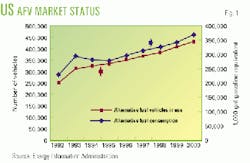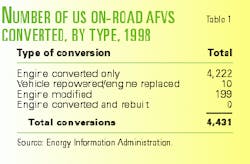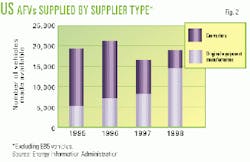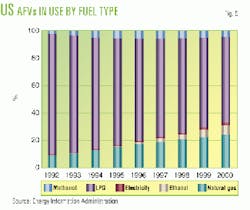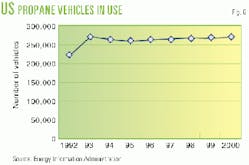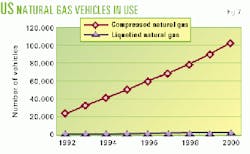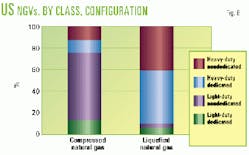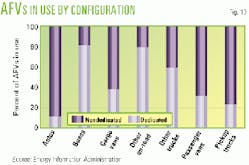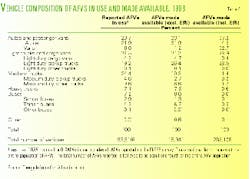The US alternative-fueled vehicle (AFV)-alternative fuels industry has undergone a number of market-related changes, beginning in the mid-1990s.
In 1994, when the US Energy Information Administration published its report, Alternatives to Traditional Transportation Fuels-an Overview, LPG was the dominant alternative transportation fuel (ATF). Most of the AFVs in use were conversions of gasoline or diesel vehicles. And the parties most interested in ATFs were governments and fuel providers.
Today, the new-vehicle manufacturers supply a much larger share of AFVs. Natural gas and other fuels have begun to erode LPG's dominant position. AFVs are available in greater variety than before, with more attention to demands for different types. There is much talk about markets, with a focus on greater penetration of certain niche markets. And there has been a significant increase in the number of organizations and activities established to promote AFV use, coordinate purchases, educate the public, etc., with the ultimate goal of increasing the numbers of AFVs operating in the US.
Although the small size of a refueling and maintenance infrastructure for AFVs still hinders the growth of the market, that infrastructure continues to grow. Vehicle cost and driving range are improving, although, in most cases, they are not yet at the points necessary to compete with traditionally fueled vehicles. This article will describe each of the ATFs and AFVs in detail. It will provide information on the development to date and look at trends likely to occur in the future.
Legislation of the 1980s and 1990s placed more emphasis on AFVs than on the alternative fuels. Therefore, much of this discussion will focus on the development of vehicle markets. However, as Fig. 1 shows, there has been growth in use of both vehicles and fuels. It is expected that, in the future, there will be more emphasis on using ATFs rather than AFVs.
Many of the data in this article were obtained from EIA's 1999 survey of AFV suppliers and users (EI-886). The survey is conducted annually and collects data on AFVs supplied, or made available, in the previous year and AFVs planned to be made available in the survey year. The survey also collects data on AFVs operated by selected user groups in the year prior to the survey. The remaining data used in this article, including data for AFV users as a whole, are estimates that were derived in 1999 using an established estimating methodology. Since 1995, EIA has published estimates of AFVs in use in the most recent year and estimates of AFVs expected to be in use in the 2 years following that.
Vehicle supplier changes
AFVs are any vehicles capable of operating on an alternative fuel, such as natural gas, LPG, alcohol, or electricity.
AFVs (except electric vehicles) may be configured as either dedicated or nondedicated vehicles. Dedicated vehicles are designed to run exclusively on one fuel.
Nondedicated vehicles can be:
- Bifueled vehicles, which can operate on either an alternative fuel or a conventional fuel-but not at the same time-and have separate onboard storage systems for each fuel.
- Flexible-fueled (also variable-fueled) vehicles, which can operate on either an alternative or conventional fuel or on a combination of them and have a single onboard storage and combustion system.
- Dual-fueled vehicles, which can burn two fuels simultaneously. In such vehicles, the fuels are not mixed in storage but are injected into the engine combustion chamber simultaneously. Dual-fuel configurations are typically used in heavy-duty vehicles. Electric vehicles are classified as either hybrid or nonhybrid vehicles. Electric hybrids and fuel-cell vehicles, which operate on electricity and another fuel, are considered nondedicated vehicles.
AFVs are supplied by either original equipment manufacturers (OEMs) or converters. An OEM is an organization that provides the original design and materials for assembly and manufacture of vehicles. It is directly responsible for manufacturing, marketing, and providing warranties for new vehicles. A vehicle converter modifies or alters a vehicle that was originally designed to operate on one fuel, usually gasoline or diesel, to operate on an alternative fuel.
An OEM might authorize an independent conversion facility to take direct delivery of its vehicles and convert the vehicles' engines to use an ATF before the vehicles are delivered to end users. In that case, the converter is called an OEM vehicle converter, and the vehicle is considered to be an OEM vehicle. If an organization or individual converts, modifies, or repowers vehicles after the vehicle's initial delivery to an end user, it is called an aftermarket vehicle conversion facility, and the AFVs are considered to be converted vehicles.
The vehicle OEMs most familiar to the US general public are the light-duty vehicle (LDV) suppliers (domestic or foreign) that usually perform the final assembly of, market, and warrant automobiles, vans, pickups, and similar vehicles. OEMs also include truck, bus, nonroad, and specialized vehicle suppliers. Converters of LDVs often install purchased conversion kits. Conversions may be performed by "in-house" staff for "in-house" vehicles or they may be performed for an organization by a second party. However, in heavy-duty vehicles, conversion may be by way of repowering or rebuilding an engine. Most aftermarket conversions today are engine conversions. Table 1 shows the incidence of different types of conversion methods for the AFVs reported on the EI-886 survey.
Although US automakers were producing AFVs for federal and demonstration fleets in the early 1990s, uncertainty about the future of AFVs made many OEMs reluctant to begin market production. However, from 1995 to 1998, OEMs increased the number of AFVs they supplied by more than 40 times. The reason for such a dramatic increase was the decision by Chrysler Corp. and Ford Motor Co. to include flexible-fuel capability (for use with gasoline or E85-a blend of 85% ethanol and 15% gasoline) as standard on several models of vehicles.
During the same period, conversions declined, dropping by 40% during 1996-97 and by almost 50% during 1997-98 (Table 2). The two major reasons for the decline are the implementation by the US Environmental Protection Agency of an addendum to its Memorandum 1A, which limited the number of conversion kits certified for use, and the availability of more OEM AFVs, which are usually more efficient than conversions.
In 1995, 29% of all AFVs were supplied by OEMs. By 1998, 98% of AFVs were OEM vehicles. Even if E85 vehicles are excluded, the percentage of OEM-supplied AFVs had risen to 78% by 1998 (Fig. 2).
Conversion is often a way for users to get the specific type of AFV that fits their needs. As the range of alternative-fuel vehicle types provided by OEMs expanded, conversions also declined. According to EI-886 survey data in 1998, OEM AFVs were made available in 25 of 40 major vehicle categories (although many vehicle types are only available in one or two alternative-fuel types).
In October 1998, the Alternative Fuels Data Center listed 34 alternative-fuel, LDV models that were offered by OEMs to US markets for model-year 1999. They included a range of vehicle types including sedans, vans, pickups, and sport utility vehicles. The OEMs expect to offer a few more AFV models in 2000. Also in 2000, the Honda Insight and Toyota Prius will be the first gasoline-electric hybrid vehicles sold in the US. Although technically not AFVs, gasoline-electric hybrids are generally grouped with other electric vehicles.
During 1995-98, the portion of alternative-fuel autos, buses, pickups, and cargo vans supplied by OEMs climbed over the two-thirds mark (Fig. 3). Conversion, however, still appears to be an important means of supplying some types of medium and heavy-duty AFVs, particularly trucks. According to data from the EI-886 survey, in 1998, the only categories having more conversions than OEMs were trucks with gross vehicle weight greater than 16,000 lb.
By fuel type, OEM percentage growth was largest for natural gas vehicles (Fig. 4). Although the total number of NGVs made available annually has hardly changed since 1995, the percentage of CNG (compressed natural gas) vehicles supplied by OEMs increased to 85% from 20% by 1998. The number of different types of natural gas vehicles supplied by OEMs, however, has not changed significantly since 1995. There are still no OEM-supplied natural gas midsized autos, small pickups, or special-purpose vehicles, all of which had a notable number of conversions.
About half of the LPG vehicles made available in 1998 were conversions. The total number of LPG vehicles made available has decreased since 1995, when 22% of the LPG vehicles were supplied by OEMs. The OEMs offer far fewer vehicle types for LPG than for natural gas. Absent are autos, 16,000-26,000-lb trucks, large pickups, and school buses, all of which have had a notable number of conversions.
The OEM percentage for electric vehicles has always been relatively high. The total number of electric vehicles made available has increased much since 1995, led mostly by OEM-supplied vehicles. The OEM percentage increased from 91% to almost 100% during 1995-98. The number of different electric vehicle types made available essentially has stayed the same.
Market trends by fuel type
The Energy Policy Act of 1992 (EPACT) specified that LPG, natural gas, alcohols in blends containing at least 85% alcohol, hydrogen, and electricity were to be considered alternative transportation fuels.
Since EPACT's enactment, two more fuels, 100% biodiesel and P-Series fuel, have been designated as alternative fuels by the US Department of Energy.
EIA estimates that almost 90% of the more than 430,000 AFVs expected to be in use in the US at the end of 2000 will be vehicles designed for LPG or natural gas.
But the shares of AFVs designed for LPG and methanol are on the decline, while the shares of natural gas, ethanol, and electric vehicles have increased since 1992 (Fig. 5).
Propane
When speaking of alternative fuels, the terms LPG and propane are often used interchangeably. LPG for vehicular use is a mixture of at least 90% propane, 2.5% butane and higher hydrocarbons, and a balance of ethane and propylene. Henceforth in this article, LPG used as a vehicle fuel will be referred to as propane.
Propane is a by-product of natural gas processing or petroleum refining. It is a gas at room temperature but turns to liquid when compressed. Liquid propane is stored in special tanks that keep it under pressure (about 200 psi). Although stored onboard vehicles as a liquid, propane is returned to a gaseous form before being burned in the engine.
Experiments using propane as a motor fuel were first conducted around 1910. During the 1950s, the conversion of conventional vehicles to AFVs became popular. A taxi fleet in Milwaukee boasted a fleet of nearly 300 taxis running on propane at that time, and the Chicago Transit system operated more than 500 propane-fueled buses. For on-road use, propane is currently used in both light and medium-duty vehicles as well as heavy-duty trucks and buses. Propane is also a popular choice for non-road vehicles, such as forklifts and agricultural and construction vehicles.
Vehicle and fuel costs remain barriers to propane's widespread use as an ATF. Many propane vehicles are conversions that typically cost $1,000-2,000. Propane retail prices were consistent with unleaded gasoline prices during the 1990s, but future propane prices are expected to be lower than those for gasoline. Because propane prices are often tied to oil prices, however, their prices can greatly fluctuate.
One frequent complaint about dual-fuel propane passenger vehicles is the loss of trunk space due to the installation of the propane tank. An advantage, however, is that propane vehicle engines are reported to last longer than gasoline or diesel engines. After conducting a study of AFVs, DeKalb County, Ga., noted that, although initial acquisition costs were steep, the long-term savings on fuel costs and maintenance outweighed the short-term costs.
It is estimated that, in 1998, there were 266,000 on-road propane vehicles in use in the US. Although that is the largest number of all AFVs, propane vehicles experienced the slowest growth during 1992-98 (Fig. 6). As a result, propane has lost some of its market share. The greatest concentration of propane vehicles is in the south, where large numbers are operated in the oil and gas-producing states of Oklahoma and Texas.
The propane industry has been criticized by some for not promoting the fuel's use as an ATF, particularly compared with the natural gas industry, which aggressively advertises its fuel for vehicular use. Propane industry officials have stated that the industry lacks the internal cohesion necessary to promote the use of propane as a transportation fuel. Officials have also noted that, traditionally, the propane industry has been made up of small-scale suppliers that primarily serve residential customers. Some of these suppliers fear that growth in the use of propane as a transportation fuel would cause the deterioration of the suppliers' smaller businesses. And some propane consumers have expressed concern that increasing demand for propane as a vehicle fuel would increase prices. In response, the General Accounting Office concluded, in 1998, that there will only be a small increase in propane's use as an ATF in the next 10 years and that propane consumption by nontransportation sectors will not be affected by this increased demand.
Of all the alternative-fuel types, propane has the largest percentage of converted vehicles. In 1997, propane vehicle converters were significantly impacted by EPA's addendum to Memorandum 1-A, which limited the number of conversion kits certified for use and led to a sharp decrease in the number of vehicle conversions. However, after a period of adjustment to the new regulations, it appears that conversions will continue. In addition, vehicle manufacturers are committed to producing some new propane vehicles. These factors point to steady but slow, growth in the use of propane vehicles.
Natural gas
Natural gas is a mixture of hydrocarbons (primarily methane) that mainly is extracted from underground reserves. Natural gas can also be produced as a by-product of landfill operations. It is transported to end users through a gas pipeline system that reaches every state in the Lower 48. For storage and use as an alternative fuel in vehicles, natural gas is either compressed (CNG) or liquefied (LNG). Compression usually occurs at a refueling station, where natural gas from the distribution pipeline is compressed to about 3,000 psi for vehicular purposes. Natural gas is liquefied by cooling it to -260° F. at atmospheric pressure. Liquefaction sometimes occurs off-site, and LNG is delivered by truck to the refueling station. LNG is primarily used as an alternative to diesel to operate heavy-duty vehicles, while CNG is primarily used in light and medium-duty vehicles as an alternative to gasoline.
NGVs have been in use since the 1930s. Currently, there are far more NGVs in use throughout the rest of the world than in the US. The largest numbers are found in Argentina, Italy, and Russia, where a total of about 900,000 NGVs are operated. US automakers began producing natural gas versions of some vehicles in the late 1980s and the US's first public natural gas refueling station opened in Denver in 1990.
Dedicated light-duty NGVs cost about $3,500-7,000 more than their gasoline counterparts. Some of the expense is due to the need for specialized storage tanks. As demand increases and more NGVs are sold, prices will likely decrease. NGVs have significantly fewer exhaust emissions than gasoline vehicles. Evaporative emissions are also reduced when refueling an NGV. If any natural gas escapes from the refueling nozzle, the gas will not lie along the ground or enter sewage systems, because natural gas is lighter than air. Because CNG is a gas and less dense than liquid fuels, most CNG vehicles have a shorter operating range than gasoline vehicles. LNG has a much higher energy content, and therefore LNG vehicles can travel farther on the same volume of natural gas. LNG also allows for quicker refueling, but the cost of liquefaction and of well-insulated, pressurized tanks for on-board storage adds to the cost of using LNG.
NGV use is increasing in the US (Fig. 7) It is estimated that CNG vehicles experienced an average annual growth rate of 22.6% during 1992-98.
The use of LNG vehicles has increased at an even faster pace, about 50%/year during that period, but LNG vehicles still account for less than 2% of NGVs in operation today. While NGV use has traditionally lagged behind propane vehicle use, NGVs are expected to account for 24% of all AFVs in 2000, up from 9% in 1992.
The majority of NGVs in use in the US are nondedicated, light-duty, CNG vehicles. Although the EIA-886 survey does not cover the entire population of AFVs, of the nearly 35,000 CNG vehicles reported for 1998, 75% were light-duty and 75% were nondedicated (Fig. 8). The CNG vehicles included automobiles (ranging from compact automobiles to large sedans), passenger vans, cargo vans, pickups (small to large), buses (transit and school), and trucks (weighing from 6,000 lb to over 33,000 lb.
Although heavy-duty vehicles are a much smaller percentage of NGVs than light-duty vehicles, they are responsible for more natural gas consumption. In 1998, one-fourth of the estimated NGVs in use were heavy-duty vehicles. Yet heavy-duty vehicles used about 60% of the natural gas estimated to be consumed by vehicles.
Many LNG vehicles are dedicated, heavy-duty vehicles. Nearly 55% of the roughly 700 LNG vehicles reported on the 1998 EIA-886 survey were dedicated vehicles, and 90% were heavy-duty vehicles. As a result, although they accounted for only 1.5% of NGVs in 1998, LNG vehicles consumed nearly 7% of all natural gas consumed by vehicles.
The greatest concentration of NGVs is in the West, with most of the vehicles being operated in California. Following California in the use of NGVs are Texas, New York, Oklahoma, and Arizona. The most recent fuel consumption estimates show the West consuming 44% of the natural gas used as a transportation fuel in the US.
Although the US has an abundant supply of natural gas, there are currently only about 1,300 natural gas refueling stations vs. more than 200,000 refueling stations serving gasoline and diesel. In 1999, a new Natural Gas Vehicle Industry Strategy was developed jointly by the Gas Research Institute, the Natural Gas Vehicle Coalition, and three divisions of DOE to create a working plan for the industry to increase demand for NGVs and for natural gas as a transportation fuel. Expanding the fueling infrastructure and increasing the use of NGVs by fleets are two prime focuses of the plan. The strategy lists several stakeholders as being key to the financial success of the NGV industry: local distribution companies, OEMs, fuel retailers, government, and other sources. Their activities range from investing time and money into research and development to providing capital to expand the fueling infrastructure.
Continued strong growth in the use of NGVs is expected. If current trends continue, heavy-duty and LNG vehicles will have larger roles in the natural gas vehicle market in the future. Average natural gas use per vehicle will likely increase as the number of heavy-duty NGVs increase and as more fueling sites open.
Ethanol
Generally made in the US from corn, ethanol is a liquid alcohol fuel that can be made from many biomass feedstocks, including agricultural crops, waste from agriculture and forestry, wastepaper, and municipal solid waste.
As an alternative fuel, ethanol is most typically used as E85, which is appropriate for light-duty vehicles. Another, less-common ethanol-gasoline combination is a 95-5% blend called E95. Ethanol is also used as a blending component with gasoline in a combination of 10% ethanol and 90% gasoline. This fuel, commonly known as gasohol, or E10, is not an alternative fuel. Ethanol can be blended in even lower concentrations with gasoline to produce oxygenated gasoline. Oxygenated gasoline also is not considered an alternative fuel. In the future, ethanol may have another role in transportation as a component of ethyl tertiary butyl ether (ETBE), a different type of oxygenate. ETBE is not an alternative fuel.
Alcohols were used as fuel in some of the earliest vehicles. Henry Ford's first car operated on alcohol fuel. Ethanol saw a resurgence as a gasoline extender during the oil crises of the 1970s.
The most common type of vehicle using ethanol is the flexible-fueled vehicle (FFV), which operates on either ethanol or gasoline or any combination of the two fuels. Ethanol FFVs do not cost more than gasoline vehicles. However, ethanol is generally not economical as a transportation fuel. Ethanol has received special tax incentives since the late 1970s. The original incentive reduced the federal excise tax on ethanol used as a motor fuel by 54¢/gal. Several attempts have been made to eliminate or decrease tax subsidies for ethanol fuel. Currently, the subsidy is effective through 2007.
The lack of an adequate fuel supply system is a significant barrier for ethanol and, so far, the use of E85 and E95 has been mostly limited to the Midwest. However, ethanol has been a focus for corn-producing states interested in alternative fuels. As the largest corn-producing state in the nation, Iowa is working to promote ethanol nationwide for use in AFVs by working with surrounding states to develop refueling infrastructure and to form a purchasing network.
Since 1997, vehicle suppliers have produced increasingly more flexible-fueled E85 vehicles. In June 1997, Ford announced it would make E85 flexible-fuel capability a standard on its 3.0-l. Ford Ranger pickup, starting in fall 1998. Shortly after Ford's announcement, Chrysler announced it would provide E85 flexible fuel systems as standard equipment on all of its 3.3-l. minivans, also beginning in 1998. As a result, E85 vehicles made available, as reported on EIA-886, grew from about 400 in 1995 to over 200,000 in 1998 (Fig. 9). It was recently announced that, in model year 2000, Ford will begin producing the Taurus EX as an E85 FFV, and General Motors will also offer a line of flexible-fueled E85 pickups.
It is widely understood that, with just 52 E85 refueling sites currently operating in the US, most of these FFVs will never operate on E85. Some environmental groups have criticized the automakers for making these vehicles only to better their average fuel economy ratings to meet Corporate Average Fuel Economy standards. The ethanol industry, however, argues that the large numbers of vehicles in place will encourage the development of infrastructure in many areas.
In its analysis of E85 vehicles in use, EIA has attempted to include only those vehicles that are intended for use as AFVs (e.g., to fulfill mandates or to reach environmental or economic goals that cannot be reached by traditionally fueled vehicles). Such vehicles are, for the most part, operated by fleets. With only those vehicles included, EIA estimates that the number of E85 vehicles in use experienced an average growth rate of about 105%/year during 1992-98. The number of these E85 vehicles is expected to continue growing rapidly, reaching a level of over 30,000 in 2000. Government fleets are using a number of E85 vehicles. On the EIA-886 survey, federal and state governments reported about 8,000 E85 vehicles in use in 1998, which were split about 60-40, respectively. The greatest concentration of ethanol vehicles is in the Midwest, in states such as Illinois, Iowa, Missouri, Wisconsin, and Nebraska.
Now that there are a large number of ethanol vehicles in the US marketplace, the success of increasing E85 use depends on making the cost of ethanol competitive with gasoline and building an E85 fueling infrastructure. DOE recently awarded $1 million to recipients of its "Bridge to the Corn Ethanol Industry" initiative. The DOE initiative is designed to help expand US ethanol production by bringing together the corn ethanol industry with newer technologies that produce ethanol from agricultural forest wastes and other biomass. DOE stated that the benefits would include "reducing the cost of domestic ethanol production, creating new markets for US corn growers, encouraging the production of a clean-burning alternative to gasoline, and helping to cut the US's dependence on imported oil."
Methanol
Methanol is a liquid alcohol fuel commonly made from natural gas. It can also be derived from coal or renewable resources containing carbon, such as wood waste and garbage. Methanol can provide a diversity of fuel applications in several different types of vehicles. The most typical application today is M85, a mixture of 85% methanol and 15% gasoline, which is primarily used as an alternative fuel in light-duty vehicles. M100 (pure methanol) works best in heavy-duty vehicles.
Methanol is also being tested as a source of hydrogen to power fuel cells in electric vehicles. In another transportation application, methanol is used to produce the oxygenate methyl tertiary butyl ether (MTBE), which is added to gasoline to enhance octane levels and reduce emissions. MTBE is often a component of reformulated gasoline, in which it qualifies as a replacement fuel and a clean fuel but not as an alternative fuel.
The California Energy Commission (CEC) first used methanol in a test fleet in 1978 and, since then, M85 and M100 have been most widely used in California. In the 1980s and 1990s, several thousand methanol-powered vehicles were operated by California fleets as part of CEC-sponsored programs conducted in partnership with the automobile industry. The numbers increased most dramatically after 1987, when the first flexible-fueled autos designed for M85 were commercially produced. To support methanol programs, CEC provided assistance in the development of a methanol reserve to supply fuel and a refueling infrastructure to distribute the fuel in California. At its peak, over 100 locations in California hosted methanol fueling facilities.
Today, methanol is mainly used in light-duty flexible-fuel vehicles that operate on either methanol or gasoline or a combination of the two fuels. Methanol FFVs cost about the same as a gasoline vehicle, but because of the lower energy content of methanol, their range is somewhat less. The price of methanol is subject to volatility as its demand for other uses (particularly MTBE) fluctuates.
Methanol fuel use has decreased significantly within the last five years. A sharp increase in the price of methanol in 1994 and another, less-severe one in 1997 contributed to the decline in methanol use as an alternative fuel. CEC states that, in California, the decline is due to the expiration of agreements with major fuel retailers and many FFVs being removed from service. By 1999, only 35 of the CEC-sponsored refueling sites remained, and CEC estimates that the number of methanol refueling sites in California will drop to under 20 by early 2000. Outside of California, about 15 methanol refueling sites are currently available.
Although OEMs continued to manufacture M85 FFVs through 1998, the number of M85 vehicles made available began declining after 1996. EIA estimates that the number of M85 vehicles in use is now declining and will continue to decline, as older vehicles are retired (Fig. 10). The greatest concentration of both M85 and M100 vehicles remains in California, where over 75% of all US methanol vehicles are located.
If methanol is to have a significant role in future AFV markets, it is likely to be in methanol fuel-cell vehicles. The American Methanol Institute (AMI) suggests that further development of methanol fuel cell technologies will offer potential growth for methanol demand. AMI states that, starting in 2004, Daimler Chrysler plans to produce annually 100,000 methanol fuel-cell vehicles, which will consume 100 million gal/year of methanol. AMI also states that "A clear consensus has now been reached that methanol is the automotive industry's preferred energy source for fuel-cell vehicles.
Electricity
On-road vehicles such as automobiles, pickups, vans, buses, and trucks are all capable of being electric vehicles (EVs). Smaller vehicles, such as motorcycles, forklifts, and cargo tugs can also be designed as EVs.
Three types of EVs are in use: battery-powered, hybrid, and fuel-cell. A battery-powered EV uses the electricity from on-board rechargeable batteries to run an electric motor, which turns the vehicle's wheels. A hybrid electric vehicle has two sources of motive energy. For example, it may use a lean-burn gasoline engine in combination with batteries. A fuel-cell vehicle is a type of hybrid that uses fuel cells instead of batteries. A fuel cell operates like a battery in that it converts chemical energy directly into electricity. A fuel cell combines oxygen from the air with hydrogen gas. A fuel cell does not need recharging; it produces electricity from the fuel supplied. Fuels other than pure hydrogen can be utilized by fuel cells if they are processed or reformed to provide a hydrogen-rich mixture. Alternative fuels being considered for use in fuel cells include methanol, ethanol, natural gas, propane, and hydrogen.
Around the turn of the 20th century, on-road electric vehicles outnumbered gasoline-powered automobiles. During the early 1900s, 50,000 EVs traveled the roads and streets of the US. Their popularity declined, however, once less-expensive methods of making gasoline were discovered, and the electric starter replaced the crank for gasoline-powered automobiles.
Electric vehicle and battery technology continues to improve and experience rapid growth. However, today's battery-powered EV still does not offer the range of a gasoline-powered vehicle. The typical driving range for these EVs is 50-130 miles, depending upon the vehicle's weight, number, and type of batteries and engineering and design features. Weather extremes and use of accessories (such as heating and air conditioning) can also affect the range. Battery pack replacement costs are high, so battery replacement is usually included in the price of leased vehicles. Well-designed battery-powered EVs can travel at the same speeds as conventional vehicles and provide the same safety and performance capabilities. But with typical battery recharging times of 6-8 hr, most vehicles, especially fleet vehicles, must be recharged overnight.
Hybrid EVs have longer ranges than battery-powered vehicles and don't require charging infrastructure. Hybrid EVs have several advantages over traditional internal combustion engine vehicles, including regenerative braking capability, which helps minimize the energy lost when driving; reduced engine weight; increased fuel efficiency; and decreased emissions. Hybrid EVs can also be operated using alternative fuels; therefore, they need not be dependent on fossil fuels.
A fuel-cell EV produces very little or no tailpipe emissions, like a battery-powered EV, and it has the driving range and convenience of a conventional gasoline-powered engine.
EVs cost more than gasoline-powered vehicles. Initial commercial production EVs are priced at $15,000-40,000. Many OEMs offer EVs only on a lease basis, with lease prices at $349/month or more. Tax incentives often help to defray costs.
More than 5,000 EVs were estimated to be in use in 1998 in the US, with California leading all other states by a wide margin. In 1998, California was estimated to have over 2,200 EVs in use, followed by Michigan with 311, Arizona with 274, Colorado with 258, and New York with 231. Estimates show a 22% average annual growth for EVs in use during 1992-98.
Vehicle manufacturers continue to improve technology and produce more and more EVs. The number of EVs made available grew from a level of about 500 in 1996 to over 1,800 in 1998. Although 99% of the electric vehicles made available were battery-powered, hybrid vehicles increased slightly. Most of the battery-powered vehicles in use have lead or advanced lead-acid batteries. But real-world use of battery technology is broadening, and other battery types (including nickel-metal hydride and nickel-cadmium batteries) were used in 43% of the EVs supplied in 1998.
Due to future requirements for zero-emission vehicles in California, Massachusetts, and New York, OEMs are obligated to develop EVs. Production of battery-powered EVs will probably continue at a moderate pace, as improvements in battery technology help to increase ranges. According to the Electric Transportation Coalition, the price of advanced batteries must decrease, and the performance of advanced batteries must improve, in order to produce an EV that will be widely accepted by consumers.
More use of hybrid EVs is expected in the future. Toyota has been selling its hybrid Prius in Japan and plans to introduce the vehicle to the US market in summer 2000. Honda started selling its hybrid, Insight, in the US at the end of 1999. On the user side, Tempe, Arizona, recently ordered 31 hybrid electric buses that will use LNG as their power source and expects delivery by February 2001.
The introduction of fuel-cell EVs is also expected in the future. Although fuel-cell applications for buses have been implemented, special emphasis is placed on development for light-duty vehicles, because these vehicles offer the greatest potential in energy and environmental benefits. The international divisions of OEMs and organizational partnerships seem to be spearheading the research, development, and market testing of fuel-cell vehicles, as evinced by an extensive listing of global fuel-cell activity from the Fuel Cells 2000/Breakthrough Technologies Institute (BTI). The California Fuel Cell Partnership, a unique association of auto manufacturers, fuel providers, a fuel-cell developer, and government agencies, expects to place about 50 fuel-cell passenger cars and fuel-cell buses on California roads for demonstration purposes during 2000-03.
Some OEMs have announced plans to make fuel cell EVs commercially available as early as 2004. Several concept vehicles have been built. In spring 1999, Daimler Chrysler made public its first fuel-cell vehicle, called NECAR 4 (New Electric Car), which is based on a Mercedes-Benz compact car. DaimlerChrysler is also developing NECAR 5. DaimlerChrysler has said that, for fleet applications, emphasis will be placed on using pure hydrogen fuel; for vehicles sold to the public, hydrogen reformed from methanol will be emphasized. Ford produced a concept fuel-cell vehicle called the P2000 Prodigy, which operates on on-board, stored hydrogen and performs with the same efficiency as Ford's Taurus. According to DOE's Office of Energy Efficiency, the goal of the OEMs is to ensure that safety, performance, and reliability of fuel-cell vehicles meets the expectations of the driving public.
Hydrogen
Hydrogen is not a primary fuel found in nature; it needs to be transformed from water, biomass, renewable fuels, fossil fuels, and other materials that are rich in hydrogen. Natural gas, petroleum, coal, ethanol, methanol, landfill waste, sunlight, and wind all serve as possible supply sources for hydrogen.
Today, the use of hydrogen in vehicles is primarily limited to experimental and prototype vehicles. A number of prototype vehicles burn hydrogen directly using modified automotive engines. There are also a few vehicles that use hydrogen in a fuel cell to produce electric power for electric motor drives. In addition to the direct use of hydrogen, there has been a demonstration program involving blends of up to 15% in volume of hydrogen added to natural gas to create "hythane." In this case, the hydrogen provides up to 5% of the energy content of the blend.
Cost is the largest single obstacle preventing hydrogen from becoming a popular ATF. Technological and economic constraints, including safety, the form of the fuel, and production and storage, also serve as obstacles. Maintenance, however, is one area where lower costs are expected, if hydrogen is used with fuel cell technology.
Hydrogen may be stored in compressed gas storage tanks or condensed into a dense liquid form, enabling a larger quantity of hydrogen to be stored and transported. Other storage methods include chemical hydrides, gas-on-solid adsorption, and microspheres. All of these methods are costly.
The typical form for transporting hydrogen will be in a liquefied state (LH2), which will need to be delivered by a specially designed tanker truck, similar to that used for transporting LNG. The transfer of LH2 from the tanker truck to fleet storage is as complex as that for LNG. A number of steps are involved. Before pumping hydrogen from the storage tank to a vehicle, it must be converted from liquid to gas. The gas is odorless and colorless, and if it touches human skin, cryogenic burns will result.
The DOE expects the use of hydrogen as an alternative fuel to increase in the next 20 years. The agency suggests that fuel-cell technology will provide a basis for the establishment of hydrogen in the transportation market. Hydrogen use as a transportation fuel will occur gradually, with increased research, development, and testing. Other alternative fuels will probably gain popularity sooner than hydrogen.
Biodiesel
In 1998, the DOE designated neat (100%) biodiesel, or B100, as an alternative fuel and established a credit program for biodiesel use. Biodiesel is an ester-based fuel oxygenate derived from renewable resources (e.g., soybeans, rapeseed, peanuts, and other vegetable oils-such as used cooking oil-as well as animal waste, such as beef tallow). Biodiesel can be used in pure form or blended in any ratio with petroleum diesel (petrodiesel) for use in in compression-ignition (diesel) engines.
Blended biodiesel, the most common of which is B20 (20% biodiesel; 80% petrodiesel), has not been designated as an alternative fuel. The biodiesel industry spent several years of intensive lobbying to seek approval for B20 to be categorized as an alternative fuel in the US. After legislation was introduced in the House of Representatives in favor of B20, criticism followed, most of which focused on the definition of an ATF and an AFV. Finally, in 1998, the credit program was enacted. It allows B20 users to claim credits for consuming biodiesel that can be applied against their AFV purchase requirements.
Biodiesel was introduced in South Africa before World War II to power heavy-duty vehicles. Biodiesel plants are now being built by several companies in Europe.
Using biodiesel in pure or blended form does not require engine or storage modifications as other do fuels, such as natural gas or propane. Because using biodiesel requires no engine modifications, conventional heavy-duty vehicles, such as farm equipment and buses, can operate on the fuel.
Vehicle engines running on biodiesel produce less particulate, smoke, hydrocarbons, and carbon monoxide emissions than conventional diesel engines. Biodiesel's emissions are also expected to be less toxic. Nitrogen oxide (NOx) emissions, however, are similar to those of conventional diesel.
When comparing biodiesel used in an unmodified diesel engine with petroleum diesel used in an engine, similar engine performance (i.e., power, acceleration, and fuel consumption) is found. Lubricant consumption and wear are also comparable to conventional diesel engines. Biodiesel users also state that the fuel is safe to handle because it is biodegradable and non-toxic and is safe to transport because it has a high flash point (ignition temperature). Some transit authorities who use biodiesel blends have reported lower maintenance costs than for those vehicles fueled solely on petrodiesel.
Any fleet that includes heavy-duty vehicles with diesel engines can use biodiesel. The National SoyDiesel Development Board concentrates its on-road marketing efforts on bus fleets, environmentally sensitive areas (e.g., parks), and government and military fleets.
The use of biodiesel as an alternative fuel (i.e., B100) is not expected to be significant. However, biodiesel use as a replacement fuel is expected to increase significantly, starting in 1999, when the credit program takes effect.
P-Series fuels
In mid-1999, the DOE determined that Pure Energy Corp.'s P-series fuel is "substantially nonpetroleum" and added P-Series fuels to the definition of "alternative fuel" under its Alternative Fuel Transportation Program regulations.
P-series fuels are blends of ethanol, methyltetrahydrofuran (MTHF), and pentanes-plus, with butane added for blends that would be used in severe cold-weather conditions to meet cold-start requirements. The ethanol and MTHF are derived from renewable US feedstocks, such as corn stalks, paper-mill sludge, oat hulls, wood waste from construction, and other wastes. Emissions from P-series fuels are well below federal emissions standards.
P-series fuels are designed to operate in vehicles with flexible-fueled engine technology that can operate on E85 or gasoline, or any blend of the two. Although Ford and Chrysler are mass producing FFVs, the two OEMs do not warrant the operation of their vehicles on P-series fuels because of the fuels' current lack of demand. If the demand for P-Series increases, the OEMs may decide to revise their warranting position.
P-Series is currently only available in limited quantities. To help produce P-Series, funding ($500,000) has been approved by the US Senate appropriations committee. Using this funding, the University of Louisville will conduct research and design a full-scale, economically viable refinery that will manufacture P-Series for commercial sale. The first commercial facility is planned for construction in 2000.
In July 1999, Philadelphia began a year-long trial using P-Series in two flexible-fueled sedans. The city will test the fuel while operating the cars for administrative purposes, primarily in the northern portion of the city, where the P-Series fuel tank will be located. Drivers will test the FFVs on P-Series as well as gasoline, for comparison, and will then analyze the results.
According to DOE, P-series fuels have the potential to displace about 1 billion gal/year (almost 1%) of US gasoline by 2005. Another benefit of P-series fuels is that they will help state fleets and fuel providers meet the AFV acquisition requirements under EPACT.
Market trends by vehicle type
A frequent complaint of potential AFV users, and one of the identified barriers to penetration of AFVs in the transportation market, is that the types of AFVs supplied do not meet the needs of vehicle users. The demand for AFVs has been, and continues to be, primarily from fleets. (As defined in EPACT, a fleet is a group of 20 or more vehicles owned, operated, or controlled by one entity.)
Fleet demand for vehicles differs somewhat from nonfleet demand. Fleets use larger numbers of cargo-carrying vehicles (e.g, pickup trucks) and are the primary users of heavy-duty vehicles. Table 3 shows the average vehicle composition of fleets in the US. One would expect that the types of AFVs demanded would be similar to fleet vehicle demand. According to data reported by AFV users on the EI-886 survey, in 1998, about one third of AFVs in use were light-duty trucks and vans, 24% were medium-duty trucks, and 7% were heavy-duty trucks. Twenty-nine percent were autos and passenger vans (Table 4). It appears, then, that the demand for AFVs by vehicle type is similar to the demand for fleet vehicles in general.
A look at vehicles supplied (excluding E85 vehicles, which include large volumes of light-duty vans and trucks destined for nonfleet use) shows that, in 1998, 31% of the AFVs made available were light-duty trucks and vans, 19% were medium-duty trucks, and 7.5% were heavy-duty trucks. About one third were autos and passenger vans. Overall, AFVs made available seem to meet demand with perhaps slightly too many autos and too few medium-duty trucks. However, fuel type differs significantly by vehicle type. For instance, about two-thirds of AFV automobiles (excluding E85) supplied in 1998 were CNG vehicles, with the remainder split between electricity, methanol, and propane. Fifty-six percent of the medium-duty trucks supplied were propane vehicles, and 43% were CNG vehicles. Ninety-eight percent of the heavy-duty trucks were propane vehicles.
Overall, about 40% of AFVs in use are dedicated vehicles (as reported by AFV users on the EI-886 survey). Propane, LNG, and electric (treating nonhybrids as dedicated) vehicles have larger concentrations of dedicated vehicles. Vehicles designed for CNG and alcohols are more often nondedicated vehicles. By vehicle type, autos are mostly nondedicated vehicles. Heavier trucks and buses are mostly dedicated. And midsized trucks are split about evenly between nondedicated and dedicated vehicles.
If E85 vehicles (which are all nondedicated) are excluded, about half of the AFVs made available in 1998 were dedicated vehicles. More than half of the non-E85 AFVs currently produced by OEMs are dedicated, and less than half of the converted AFVs are dedicated. If this trend continues, as OEMs supply more AFVs than converters, the overall percentage of dedicated AFVs (excluding E85 vehicles) in use should rise.
Because dedicated vehicles cannot be operated on traditional fuels, a larger concentration of dedicated vehicles in the AFV market would increase consumption of ATFs.
Acknowledgment
The author gratefully acknowledges the contributions to research and analysis for this article that were provided by Amy Jo Wheeler-Melvin, energy industry specialist, Decision Analysis Corp. of Virginia.
References
- 1. Survey data are collected on Form EIA-886, Alternative Transportation Fuels and Alternative Fueled Vehicles Annual Survey. For more information about the survey and estimates, see EIA's website, www.eia.doe.gov.
- 2. In some cases, one OEM assembles a final product, but that product is marketed and warranted by another OEM.
- 3. The vehicle delivered from the OEM to the converter could be a traditional gasoline or diesel-fueled vehicle or a "glider" (vehicle without an engine or motor).
- 4. The repowering process does not use a conversion system; the old conventionally fueled engine is removed and replaced in its entirety by an engine designed to operate on an ATF. Sometimes, beyond converting an engine, the engine is rebuilt to take advantage of the capabilities offered by the ATF. For example, an engine might be converted to operate on natural gas or propane and be further modified to take advantage of higher compression ratios associated with gaseous fuels.
- 5. Butane-Propane News, Vol. 31, No. 6 (Arcadia, Calif., June 1999), pp. 27-29.
- 6. California Energy Commission, "Liquid Petroleum Gas/Propane-Powered Vehicles," online, http://www.energy.ca.gov/afvs/lpg/propane.html.
- 7. Butane-Propane News, "Fleet Manager Says Propane is the Best Alternative Fuel for DeKalb County, Ga.," online, Http:www.bpnews.com/htmlfile/otherhtm/April/apr98005.html.
- 8. US General Accounting Office, "Including Propane as an Alternative Motor Fuel Will Have Little Impact on Propane Market," GAO/RCED-98-260 (September 1998) pp. 1-7.
- 9. Natural Fuels Co. LLC, Q & As, Online, Http://www.Naturalfuels.com/4.htm.
- 10. Natural Gas Vehicle Coalition, Questions and Answers About Natural Gas Vehicles, p. 5.
- 11. National Conference of State Legislatures, Alternative Fuels: A Case Report, online, http://www.ncsl.org/programs/esnr/altnfex.html.
- 12. It is estimated that, in 1999, there were about 550,000 additional vehicles that were capable of operating on E85, but were not being used for AFV purposes. Thus, they were not included in EIA's estimates.
- 13. Renewable Fuels Association, Ethanol Report, online, http://www.ethanolrfa.org/er022599.html.
- 14. California Energy Commission, California's Methanol Experience, online, http://www.energy.ca.gov/afvs/altfuelbriefs/afbvol6no5.html, p. 1.
- 15. American Methanol Institute, Methanol Industry Challenges and Opportunities, and Methanol Key to DaimlerChrysler's Fuel Cell Vehicle Plan, online, http://www.methanol.org.
- 16. California Energy Commission, Alternative Fuel Vehicles, They're in Your Future, online, http://www.energy.ca.gov/education/AFVs/electric.html.
- 17. Hybrid vehicles that use gasoline or diesel engines in conjunction with an electric motor are not defined as alternative fueled vehicles by EPACT.
- 18. California Air Resources Board, Fuel Cell Electric Vehicles, online, http://www.arb.ca.gov/msprog/zevprog/fuelcell/fcell_fs.pdf.
- 19. Environmental News Network Inc. "DaimlerChrysler unveils fuel-cell vehicle." online, http://www.enn.com/enn-news-archive/1999/03/031899/necar4_2203.asp.
- 20. "DaimlerChrysler Still Leads on Fuel Cells-But Fueled by Hydrogen or Reformed Methanol?" online, http://www.calstart.org: 80/panda/homepage_news/990317_daimlerchrysler.html.
- 21. "Fuel Cells in Transportation: What in the World is Going On?," (Washington, DC: Fuel Cells 2000/Breakthrough Technologies Institute, February 1999).
- 22. An Introduction to Biodiesel: European and North American Activities (Overland Park, KS: Midwest Biofuels, Inc.).
- 23. Ibid.
- 24. Butane-Propane News, Vol. 31, No. 7, July 1999), pp. 10-11.
- 25. National Association of Fleet Administrators, FleetFocus, Vol. 2, No. 12 (Iselin, NJ, June 9, 1999), p. 1.
This article was prepared by the Energy Information Administration, the independent statistical and analytical agency within the US Department of Energy. The information contained herein should be attributed to EIA and should not be construed as advocating or reflecting any policy position of DOE or of any other organization.
A complete bibliography related to this article is available from the author via e-mail at [email protected].
The author-
Mary Joyce is an industry economist at the Energy Information Administration in the US Department of Energy. She has worked with the alternative-fuels program since 1994. She is responsible for estimating and analyzing the use of alternative transportation fuels and alternative-fueled vehicles in the US. Joyce authored the EIA article "Alternative Transportation Fuels" in 1991 and has co-authored the annual report "Alternatives to Traditional Transportation Fuels" since 1995. She previously analyzed refining and gasoline issues in EIA's Office of Oil and Gas. Prior to her work with DOE-EIA, Joyce was an economist at the US Department of Commerce, estimating several components of the Gross Domestic Product Accounts. She received her degree in economics from the College of William and Mary in Virginia.

